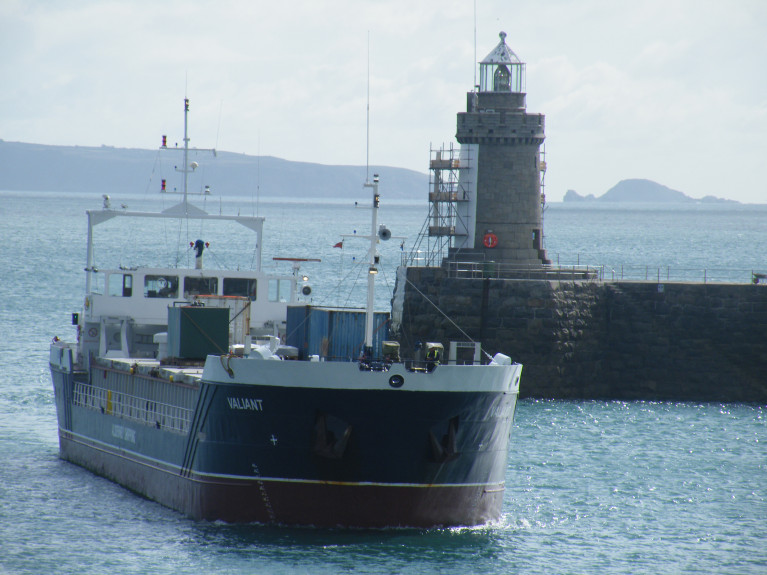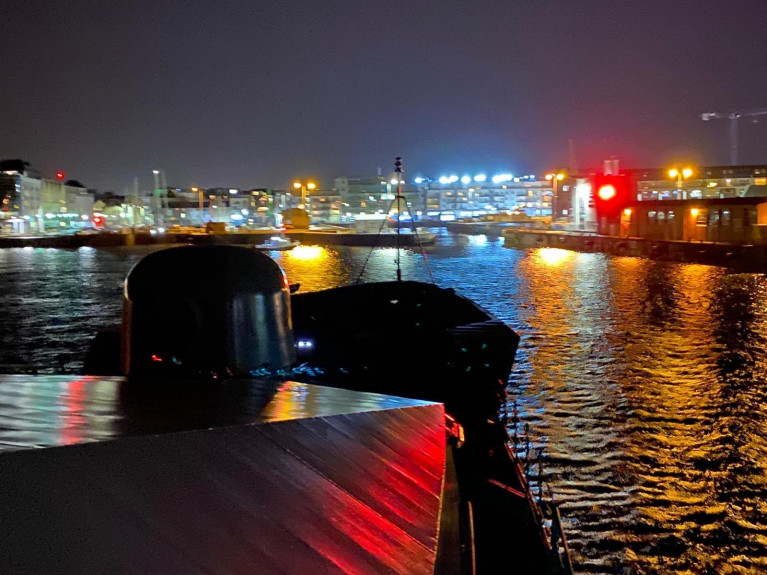Displaying items by tag: Dublin & Galway
Sisterships of Previous & Current Operator At Irish Ports Either Side of the Midlands
Ships come and go and at times sisters can be in Irish Port waters at the same time albeit apart and also serving different owners as in an example of today, writes Jehan Ashmore.
The ship's been the Alsterdiep (2008/2,954grt) which is currently at anchorage in Dublin Bay on the eastern seaboard. Whereas the newer 2009 built but slightly smaller sister, Vitality of 2,984 gross tonnage is located on the opposite west coast while docked in the Port of Galway. (See: related story of Norwegian flagged ship averted from disaster).
Alsterdiep is operated as part of the Hartmann Group with global offices among them a headoffice located in Leer, Germany. The vessel had sailed from Shoreham, an English Channel port and is awaiting in the bay to enter Dublin Port this evening to Alexandra Basin.
The Vitality formerly the Allerdiep, a similar name of the Alsterdiep as suggests had served the same German shipping group until almost a decade ago when renamed in September, 2010.
Both the ports in Dublin and Galway are almost virtually on the same latitude and just short of 220kms in distance apart based on a route taken on the M6 motorway.
This main national road connecting the capital and the 'City of the Tribes' is from where the coastal cargoship Saoirse Na Mara was also in port. Albeit this former Norwegian flagged vessel uses the Outer Pier exclusively serving the Aran Islands trade of a Government awarded contract to Lasta Mara Teoranta to provide the cargo service.
As for Vitality is operated from waters closer to home compared in the case of Alsterdeip, as the former ship is controlled in the neighbouring UK. This is where Faversham Ships Ltd (coastal town in Kent) operate a fleet. The shipowner is actually based in East Cowes, Isle of Wight with an associate company based in the Netherlands.
Vitality had sailed from Liverpool 'light' (without cargo) to the Irish mid-west port as Afloat confirmed with the City of Galway Shipping Agency, which was established almost a century ago in 1921. The cargoship had been loading limestone and as scheduled departed this evening and is bound for Ayr in south-west Scotland.
Ahead in Galway Bay was the aforementioned Saoirse na Mara (1980/597grt) which this evening is bound for Inishmaan, located between the other two Aran Islands.
A fleetmate of Vatality the smaller Valiant (1993/1,512grt), Afloat spotted back a few years ago while operating on the English Channel as an inter Channel Island routine ship operating on behalf of Channel Seaways, part of Alderney Shipping.
The Poole-Channel Islands operator competes with Channel Island Lines based out of Southampton where the Irish flagged short-sea trader Huelin Dispatch of Dundalk Shipping was chartered but this has ceased. Earlier this year the ship however returned to Irish waters to receive a routine dry-docking in Rushbrooke, Cork Harbour.
Afloat today tracked Huelin Dispatch (2012/2,597grt) in UK waters having departed Tees and is bound for Hull also on the North Sea and beforehand of recent months Norway among Scandinavian waters. The short-sea drycargo ship was built by the Dutch Damen shipyard group and to their own Combi Coaster 3850 design which has proven popular for ship-charterers. The design has also favoured Faversham Ships with a quartet in service following the introduction in 2018 of the Ventura which joined the Vedette, Beaumont and Musketie.
Another cargoship docked in Galway and opposite of Vitality in the lead in channel to Dun Aengus Dock proper is Wilson Calais (2001/2,994grt) which has been to Galway before and on one occasion to discharge wind-turbine blades. The current call of the Norwegian ship's operator, Wilson Management of Bergen saw them deploy the vessel make a short coastal passage around Co. Clare from Limerick Docks, a voyage duration taking almost 12 hours.
Scrap metal was loaded onto the Wilson ship which acquired a pair of Arklow Shipping 'R' class dry-cargoships this year.
Afloat will have more to report on the relationships of such shipping links as highighted to showcase the shipping scene in domestic waters, the Irish Sea and neighbouring waters of the UK and those of the Channel Islands.
Use of Naval Ships Looked by HSE to Scale up Covid-19 Testing Across Country (Includes Port of Galway)
In efforts by the HSE which is continuing to expand on its Covid-19 testing capabilities, tens of thousands of people calling to seek a test for the virus.
At a HSE briefing (yesterday, 17 March), officials urged people not to call the emergency line 112/999, warning that over the weekend people were “clogging up” the service.
“This is a real concern for us,” HSE CEO Paul Reid said.
For much more the Journal.ie reports that also referred in its story that officials pointed out that members of the Irish Navy have “considerable experience” with this kind of work in the Mediterranean and would be well equipped to handle it.
Afloat adds the Naval Service LÉ William Butler Yeats (as above) last night arrived at the Port of Galway where it docked as part of Óglaighnahéireann’s efforts to generate more capacity for the HSE.
The deployment follows that of sister of the OPV90/P60 class LÉ Samuel Beckett berthed in Dublin Port to also assist in fighting Covid-19. This is the second such ship (so far) that Afloat is aware involved in such critical operations.

























































